Acetylcholinesterase (AChE) Reversible Inhibitors: The Role of Oxamyl in the Production of Poisoned Baits
Abstract
:1. Introduction
2. Materials and Methods
2.1. Study Area
- Lombardy (Lat 45.67° North; Long 9.5° East) and Emilia-Romagna (Lat 44.75° North; Long 11° East), which are two regions located in northern Italy, with a total area of 46,308 km2 and 14.4 million inhabitants [30];
- Lombardy borders Switzerland to the north, and Trentino-Alto Adige and Veneto to the east;
- Piedmont to the west and Emilia-Romagna to the south. Emilia-Romagna is bordered to the north by Lombardy and Veneto, to the west by Lombardy and Piedmont, to the south by Liguria, Tuscany, Marche, and the Republic of San Marino, and to the east by the Adriatic Sea.
2.2. Laboratory Analysis
3. Results
- Mantua: thirteen samples of maize and one of gastrointestinal content;
- Ferrara: six samples of apples, two samples of maize, three of gastrointestinal contents, and one chicken carcass;
- Cremona: six samples of maize, one sample of bread, and one meatball;
- Brescia: six chicken carcasses and one maize sample;
- Milan: four samples of maize;
- Parma: two poultry carcasses;
- Forlì: one apple sample.
4. Discussion
5. Conclusions
Author Contributions
Funding
Institutional Review Board Statement
Informed Consent Statement
Data Availability Statement
Acknowledgments
Conflicts of Interest
References
- Matošević, A.; Bosak, A. Carbamate Group as Structural Motif in Drugs: A Review of Carbamate Derivatives used as Therapeutic Agents. Arh. Hig. Rada Toksikol. 2020, 71, 285–299. [Google Scholar] [CrossRef] [PubMed]
- Silberman, J.; Taylor, A. Carbamate Toxicity. In StatPearls; StatPearls Publishing: Treasure Island, FL, USA, 2022. [Google Scholar]
- Lenina, O.A.; Zueva, I.V.; Zobov, V.V.; Semenov, V.E.; Masson, P.; Petrov, K.A. Slow-binding reversible inhibitor of acetylcholinesterase with long-lasting action for prophylaxis of organophosphate poisoning. Sci. Rep. 2020, 10, 16611. [Google Scholar] [CrossRef] [PubMed]
- RASFF Annual Report 2020. Available online: https://food.ec.europa.eu/system/files/2021-08/rasff_pub_annual-report_2020.pdf (accessed on 13 July 2022).
- Di Blasio, A.; Bertolini, S.; Gili, M.; Avolio, R.; Leogrande, M.; Ostorero, F.; Ru, G.; Dondo, A.; Zoppi, S. Local context and environment as risk factors for acute poisoning in animals in northwest Italy. Sci. Total Environ. 2020, 709, 136016. [Google Scholar] [CrossRef] [PubMed]
- Bille, L.; Toson, M.; Mulatti, P.; Dalla Pozza, M.; Capolongo, F.; Casarotto, C.; Ferrè, N.; Angeletti, R.; Gallocchio, F.; Binato, G. Epidemiology of animal poisoning: An overview on the features and spatio-temporal distribution of the phenomenon in the north-eastern Italian regions. For. Sci. Intern. 2016, 266, 440–448. [Google Scholar] [CrossRef]
- Italian Official Gazette. 2009. Available online: https://www.gazzettaufficiale.it (accessed on 21 June 2022).
- Berny, P. Pesticides and the intoxication of wild animals. J. vet. Pharmacol. Therap. 2007, 30, 93–100. [Google Scholar] [CrossRef]
- Avolio, R.; Andreoli, T.; Ercolini, C.; Mignone, W.; Beltrame, R.; Razzuoli, E.; Modesto, P.; Zoppi, S.; Crescio, M.I.; Ostorero, F.; et al. Retrospective data analysis of animal poisoning events in Liguria. Vet. Anim. Sci. 2021, 13, 100178. [Google Scholar] [CrossRef]
- Mishra, S.; Pang, S.; Zhang, W.; Lin, Z.; Bhatt, P.; Chen, S. Insights into the microbial degradation and biochemical mechanisms of carbamates. Chemosphere 2021, 279, 130500. [Google Scholar] [CrossRef]
- Murphy, L.A.; Kagan, R. Poisoning. In Veterinary Forensic Pathology; Springer: Berlin/Heidelberg, Germany, 2018; Volume 2, pp. 75–87. [Google Scholar]
- Gallocchio, F.; Moressa, A.; Stella, R.; Rosin, R.; Basilicata, L.; Bille, L.; Toson, M.; Biancotto, G.; Lega, F.; Angeletti, R.; et al. Fast and simultaneous analysis of carbamate pesticides and anticoagulant rodenticides used in suspected cases of animal poisoning. For. Sci. Intern. 2021, 323, 110810. [Google Scholar] [CrossRef]
- US Environmental Protection Agency. Extremely Hazardous Substances (EHS) Chemical Profiles and Emergency First Aid Guides. Washington, D.C.: US Government Printing Office. 1998. Available online: https://www3.epa.gov/pesticides/chem_search/reg_actions/reregistration/fs_PC-103801_1-Nov-00.pdf (accessed on 21 June 2022).
- Pohanish, R. Sittig’s Handbook of Pesticides and Agricultural Chemicals, 2nd ed.; William Andrew Publishing: Norwich, NY, USA, 2015; pp. 618–628. [Google Scholar]
- El-Sherif, A.G.; Refaei, A.R.; El-Nagar, M.E.; Salem, H.M.M. Integrated management of Meloidogyne incognita infecting eggplant by certain organic amendment, Bacillus thuringiensis and oxamyl with reference to N P K and total chlorophyll status. Plant Pathol. J. 2007, 6, 147–152. [Google Scholar] [CrossRef]
- Bromilow, R. Breakdown and fate of oximecarbamate nematicides in crops and soils. Ann. Appl. Biol. 1973, 75, 473–479. [Google Scholar]
- Tomlin, C.D.S. The Pesticide Manual: A World Compendium, 11th ed.; British Crop Protection Council: Surrey, UK, 1997; p. 909. [Google Scholar]
- Spencer, E.Y. Guide to the Chemicals Used in Crop Protection, 7th ed.; Publication 1093; Research Institute, Agriculture Canada: Ottawa, ON, Canada, 1982; p. 430.
- Gallego, S.; Devers-Lamrani, M.; Rousidou, K.; Karpouzas, D.G.; Martin-Laurent, F. Assessment of the effects of oxamyl on the bacterial community of an agricultural soil exhibiting enhanced biodegradation. Sci. Total Environ. 2019, 651, 1189–1198. [Google Scholar] [CrossRef]
- Osman, K.A.; Al-Rehiayani, S.M.; Al-Deghairi, M.A.; Salama, A.K. Bioremediation of oxamyl in sandy soil using animal manures. Int. Biodeterior. Biodegrad. 2009, 63, 341–346. [Google Scholar] [CrossRef]
- Italian Portal on Phytosanitary Products. Available online: http://www.fitosanitari.salute.gov.it (accessed on 21 June 2022).
- King, A.M.; Aaron, C.K. Organophosphate and Carbamate Poisoning. Emerg. Med. Clin. North Am. 2015, 33, 133–151. [Google Scholar] [CrossRef]
- Martínez-Haro, M.; Mateo, R.; Guitart, R.; Soler-Rodríguez, F.; Pérez-López, M.; María- Mojica, P.; Garciía-Fernández, A.J. Relationship of the toxicity of pesticide for- mulations and their commercial restrictions with the frequency of animal poisonings. Ecotoxicol. Environ. Saf. 2008, 69, 396–402. [Google Scholar] [CrossRef]
- Rosman, Y.; Makarovsky, I.; Bentur, Y.; Shrot, S.; Dushnistky, T.; Krivoy, A. Carbamate poisoning: Treatment recommendations in the setting of a mass casualties event. Am. J. Emerg. Med. 2009, 27, 1117–1124. [Google Scholar] [CrossRef]
- EFSA Scientific Report (2005) 26, 1–78, Conclusion on the Peer Review of Oxamyl. Available online: https://efsa.onlinelibrary.wiley.com/doi/pdf/10.2903/j.efsa.2005.26r (accessed on 21 June 2022).
- EXTOXNET: Extension Toxicology Network. Pesticide Information Profiles. Available online: http://extoxnet.orst.edu/pips/oxamyl.htm (accessed on 21 June 2022).
- Poisoning Wildlife—A Growing Threat in Europe. Available online: https://wilderness-society.org/poisoning-wildlife-a-growing-threat-in-europe/ (accessed on 21 June 2022).
- Ruiz-Suárez, N.; Boada, L.D.; Henríquez-Hernández, L.A.; González-Moreo, F.; Suárez-Pérez, A.; Camacho, M.; Zumbado, M.; Almeida-González, M.; Del Mar Travieso-Aja, M.; Luzardo, O.P. Continued implication of the banned pesticides carbofuran and aldicarb in the poisoning of domestic and wild animals of the Canary Islands (Spain). Sci. Total Environ. 2015, 505, 1093–1099. [Google Scholar] [CrossRef]
- National Portal of Malicious Poisonings in Animals, Experimental Zooprophylactic Institute Lazio and Tuscany. Available online: https://avvelenamenti.izslt.it/ (accessed on 21 June 2022).
- Italian Institut of Statistics (Istat). Available online: https://www.istat.it (accessed on 21 June 2022).
- Chiari, M.; Cortinovis, C.; Vitale, N.; Zanoni, M.; Faggionato, E.; Biancardi, A.; Caloni, F. Pesticide incidence in poisoned baits: A 10-year report. Sci. Total Environ. 2017, 601–602, 285–292. [Google Scholar] [CrossRef]
- Tolomio, M.; Borin, M. Controlled drainage and crop production in a long-term experiment in North-Eastern Italy. Agric. Water Manag. 2019, 222, 21–29. [Google Scholar] [CrossRef]
- Lombardy Agriculture. Available online: https://www.en.regione.lombardia.it/wps/portal/site/en-regione-lombardia/business/agriculture (accessed on 21 June 2022).
- Gaglio, M.; Tamburini, E.; Castaldelli, G.; Fano, E.A. Modeling the ecosystem service of agricultural residues provision for bioenergy production: A potential application in the Emilia-Romagna region (Italy). Ecol. Model. 2021, 451, 109571. [Google Scholar]
- Bertero, A.; Chiari, M.; Vitale, N.; Zanoni, M.; Faggionato, E.; Biancardi, A.; Caloni, F. Types of pesticides involved in domestic and wild animal poisoning in Italy. Sci. Total Environ. 2020, 707, 136129. [Google Scholar] [CrossRef]
- Kennedy, G.L. Acute toxicity studies with oxamyl. Fundam. Appl. Toxicol. 1986, 6, 423–429. [Google Scholar] [CrossRef]
- Anguiano, G.A.; Amador, A.; Moreno-Legorreta, M.; Arcos-Ortega, F.; Vazquez-Boucard, C. Effects of Exposure to Oxamyl, Carbofuran, Dichlorvos, and Lindane on Acetylcholinesterase Activity in the Gills of the Pacific Oyster Crassostrea gigas. Environ. Toxicol. 2010, 25, 327–332. [Google Scholar] [CrossRef] [PubMed]
- Parker, M.L.; Goldstein, M.I. Differential Toxicities of Organophosphate and Carbamate Insecticides in the Nestling European Starling (Sturnus vulgaris). Arch. Environ. Contam. Toxicol. 2000, 39, 233–242. [Google Scholar] [CrossRef]
- Soydan, E.; Olcay, A.C.; Bilir, G.; Tas, O.; Senturk, M.; Ekinci, D.; Supuran, C.T. Investigation of pesticides on honeybee carbonic anhydrase inhibition. J. Enzym. Inhib. Med. Chem. 2020, 35, 1923–1927. [Google Scholar] [CrossRef] [PubMed]
- Kennedy, G.L. Chronic toxicity, reproductive, and teratogenic studies with oxamyl. Fundam. Appl. Toxicol. 1986, 7, 106–118. [Google Scholar] [CrossRef]
- Bollo, E.; Pregel, P.; Gennero, S.; Pizzoni, E.; Rosati, S.; Nebbia, P.; Biolatti, B. Health status of a population of nutria (Myocastor coypus) living in a protected area in Italy. Res. Vet. Sci. 2003, 75, 21–25. [Google Scholar] [CrossRef]
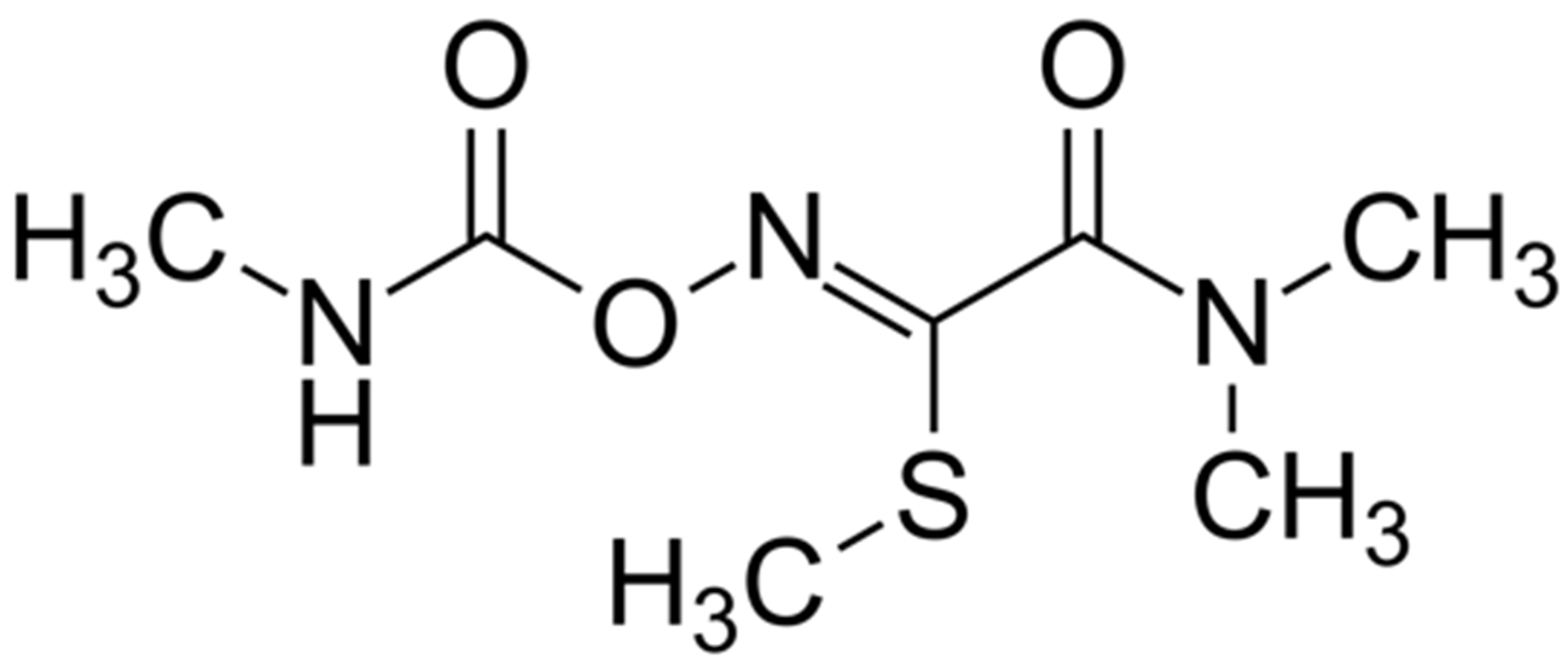
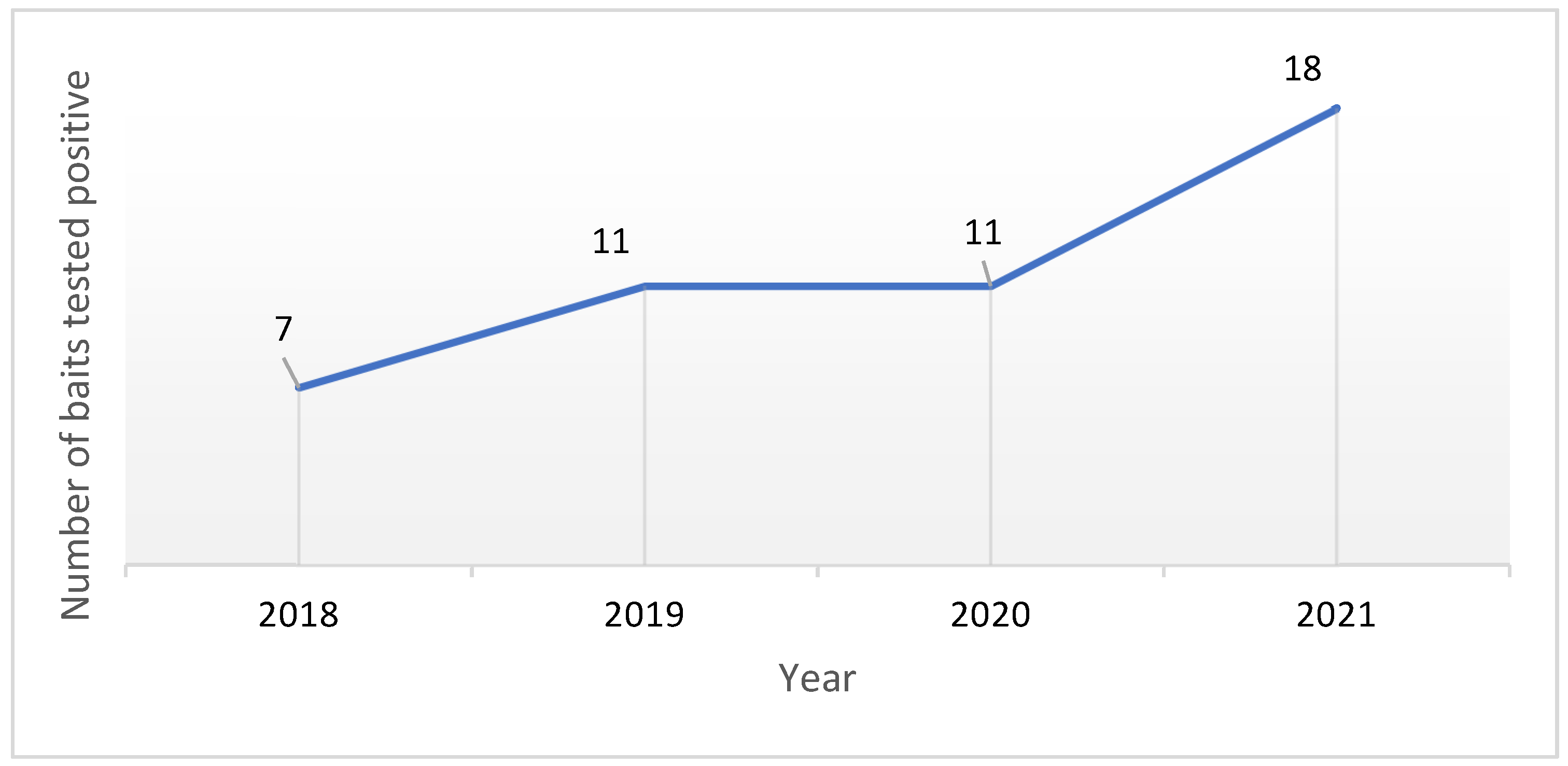
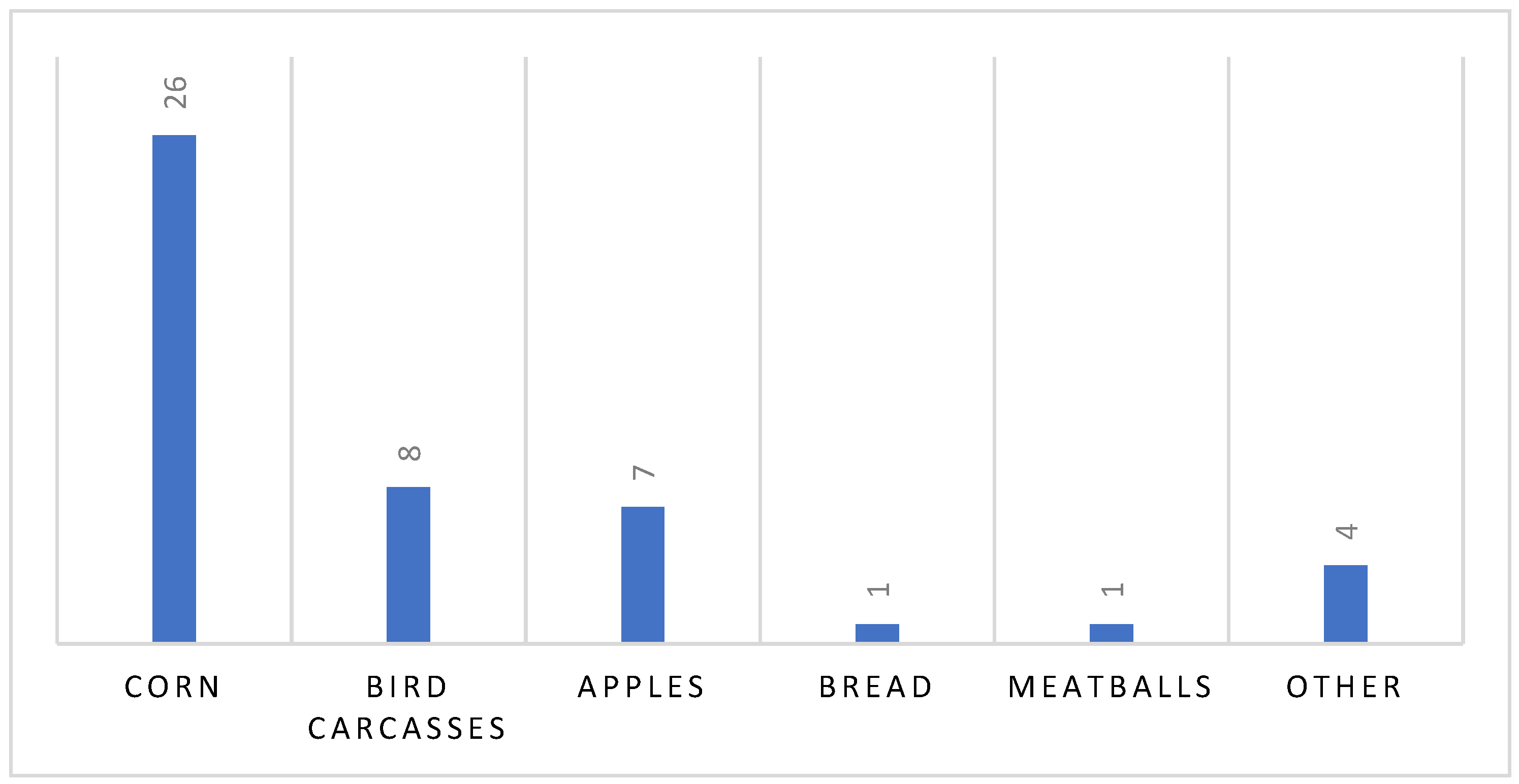
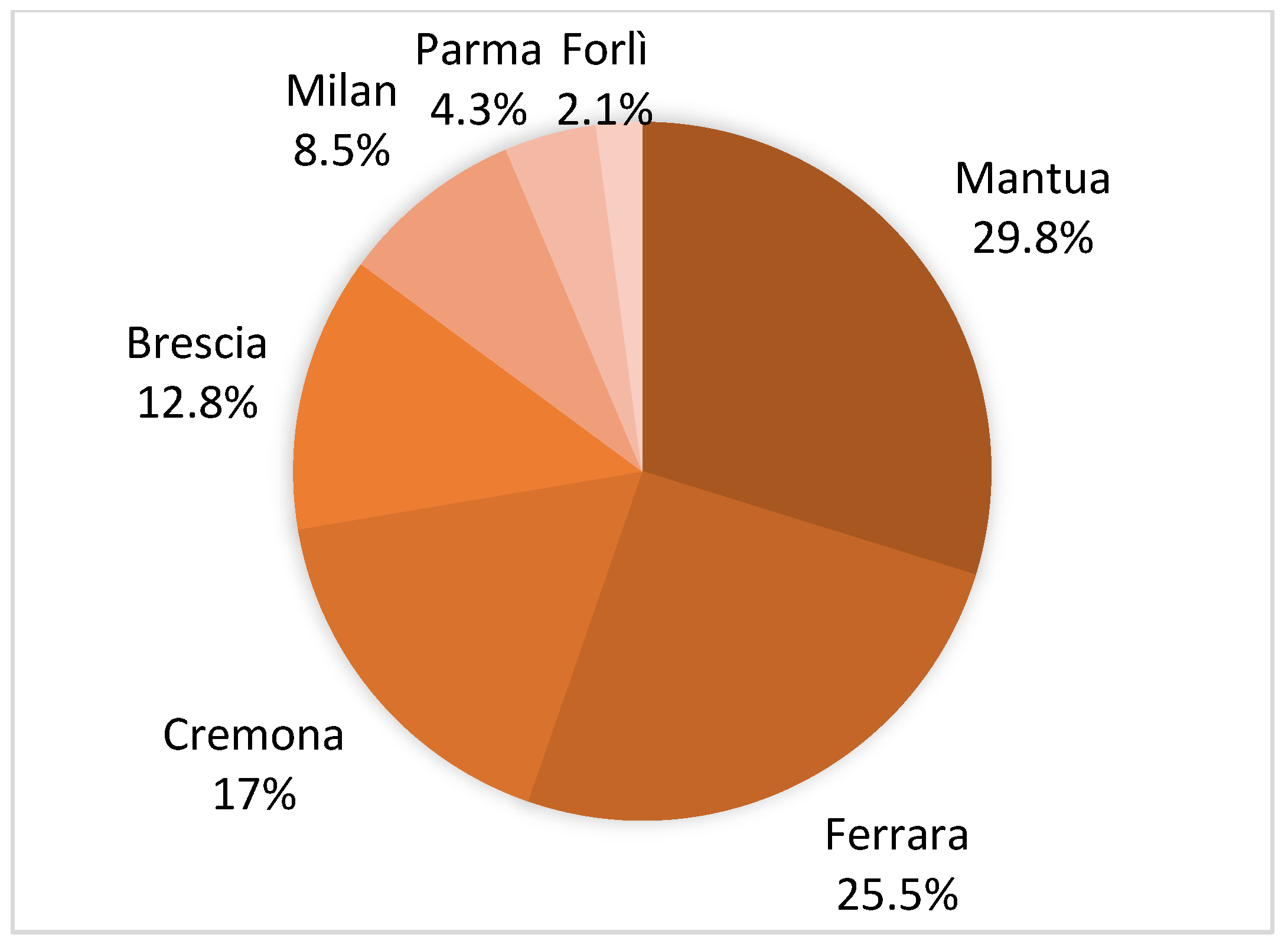
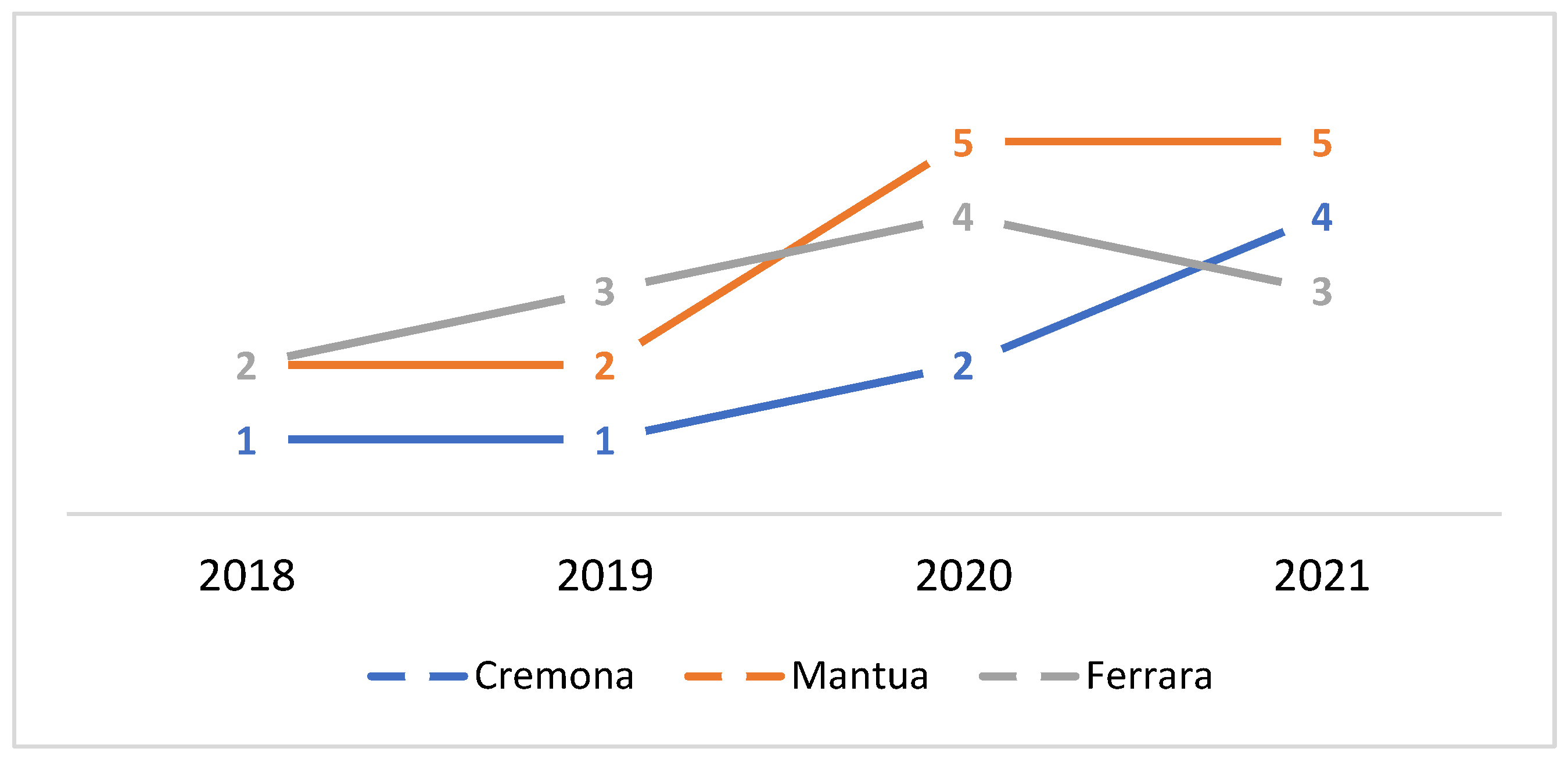
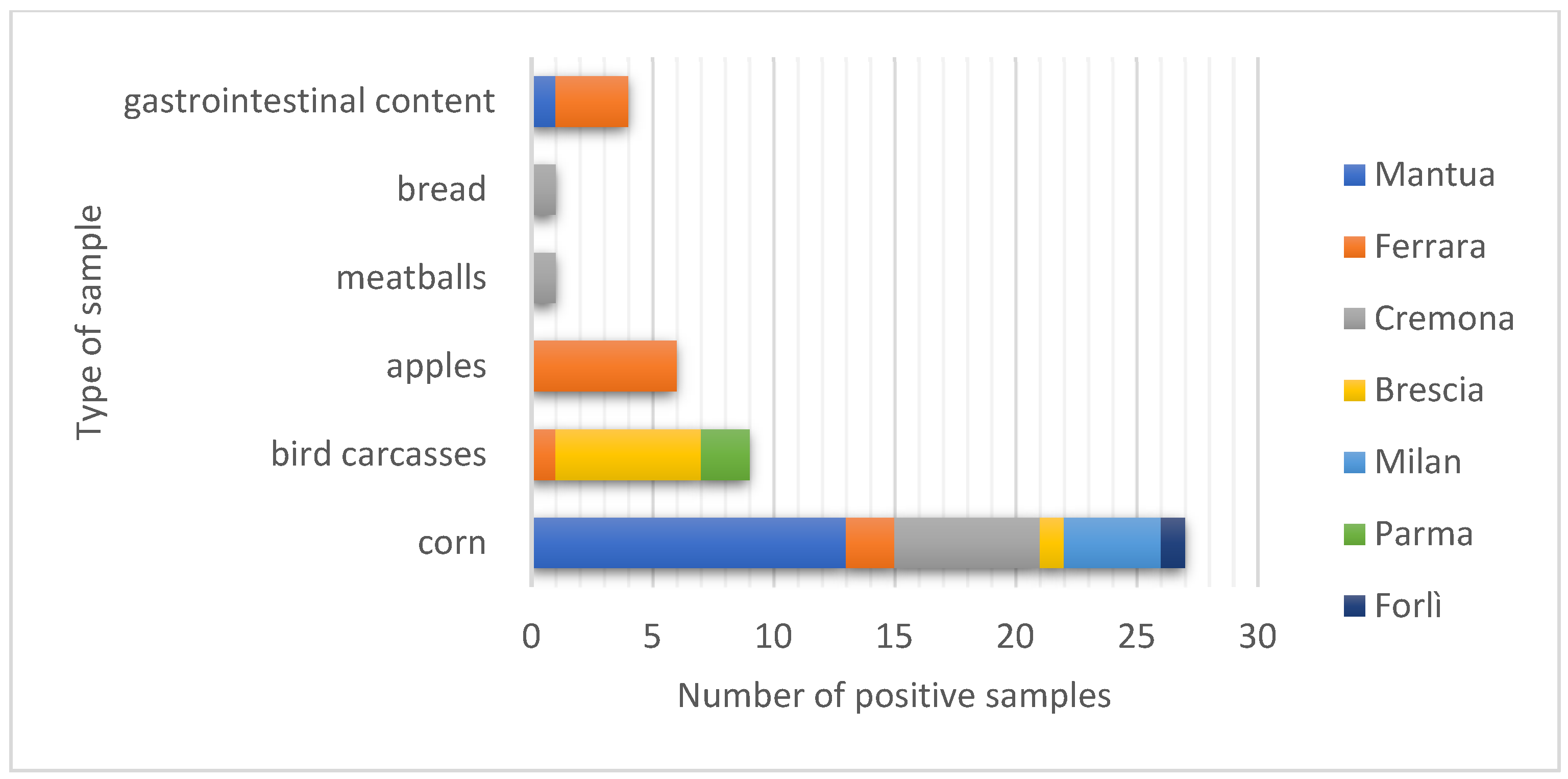
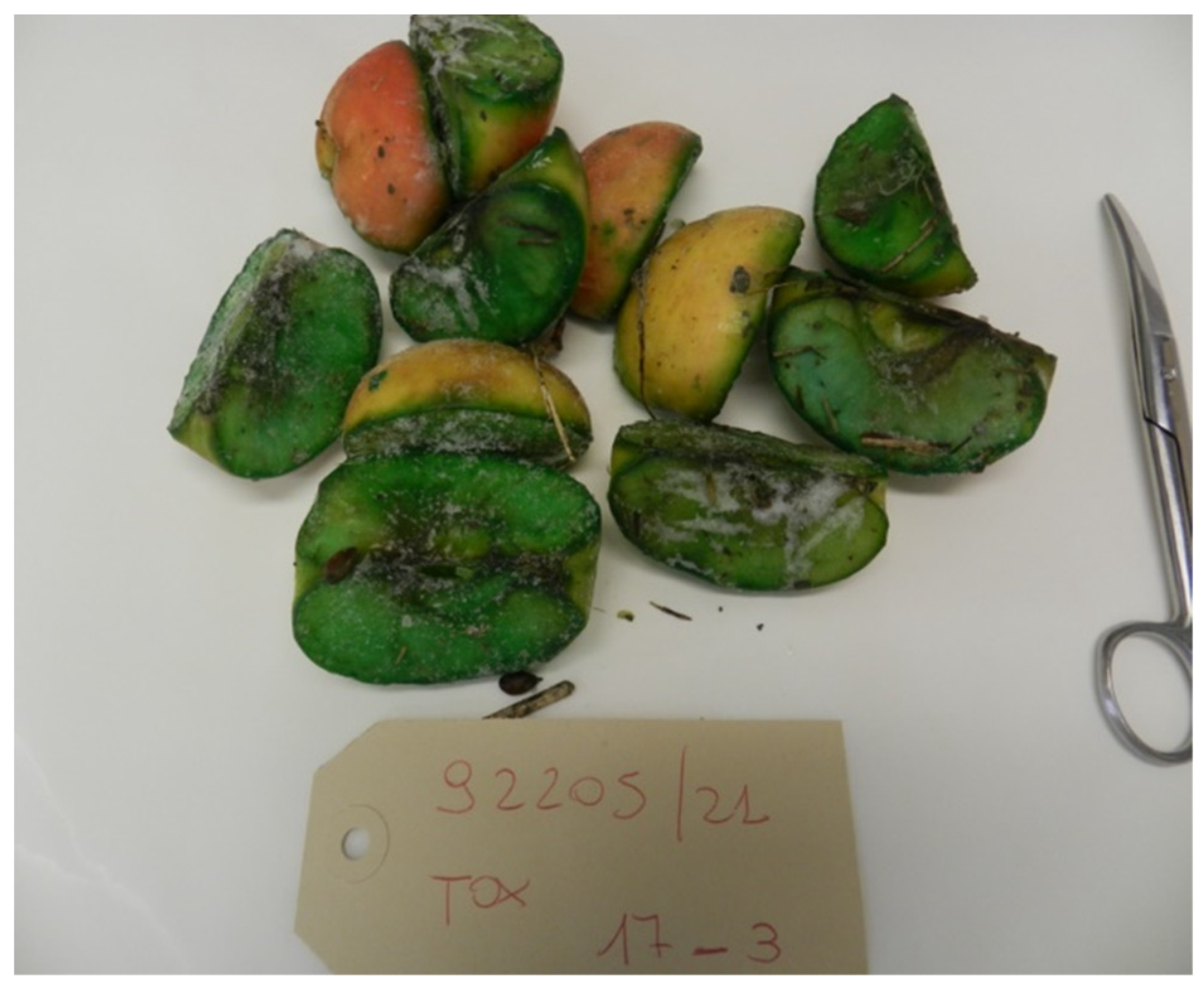
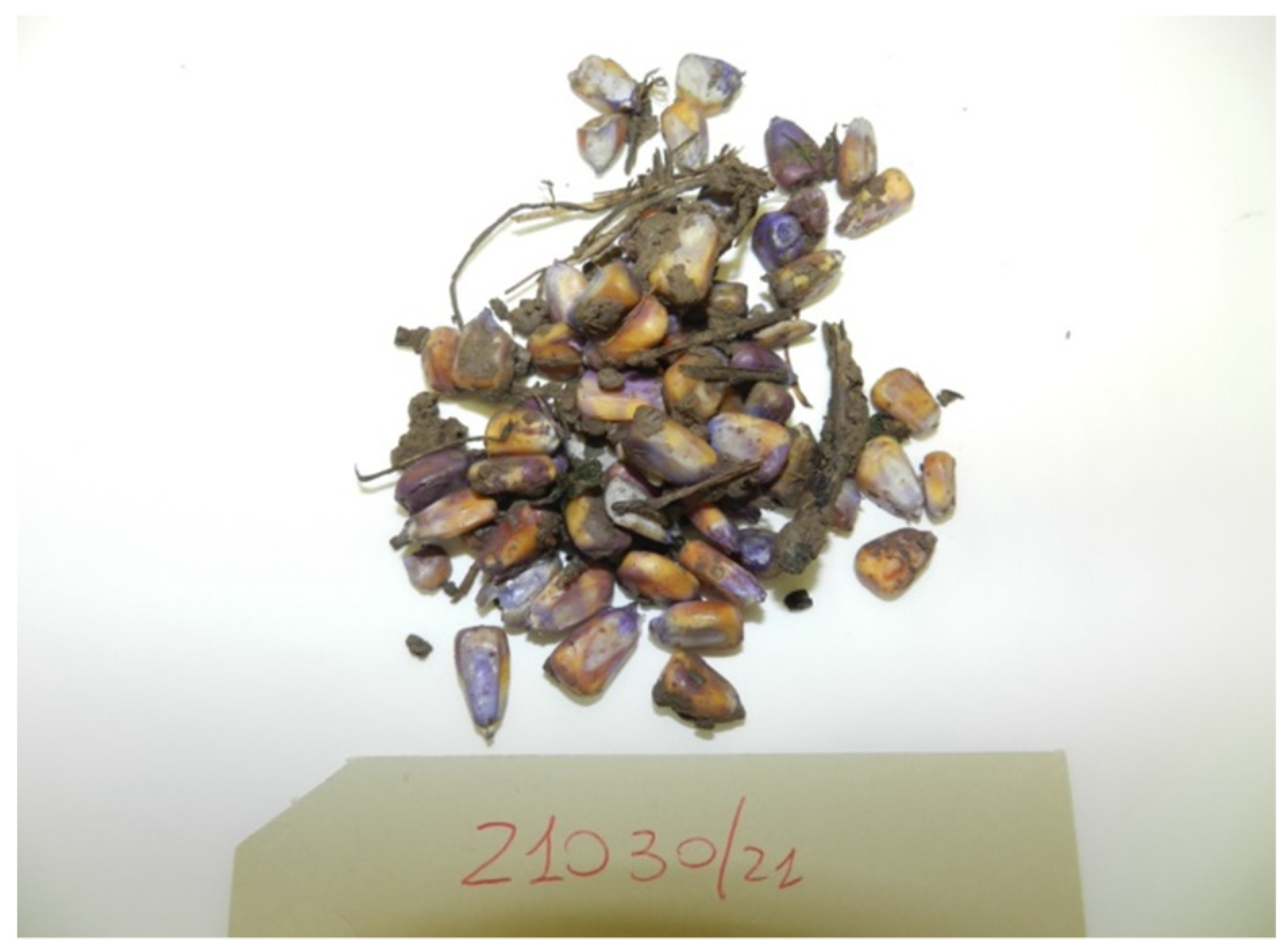
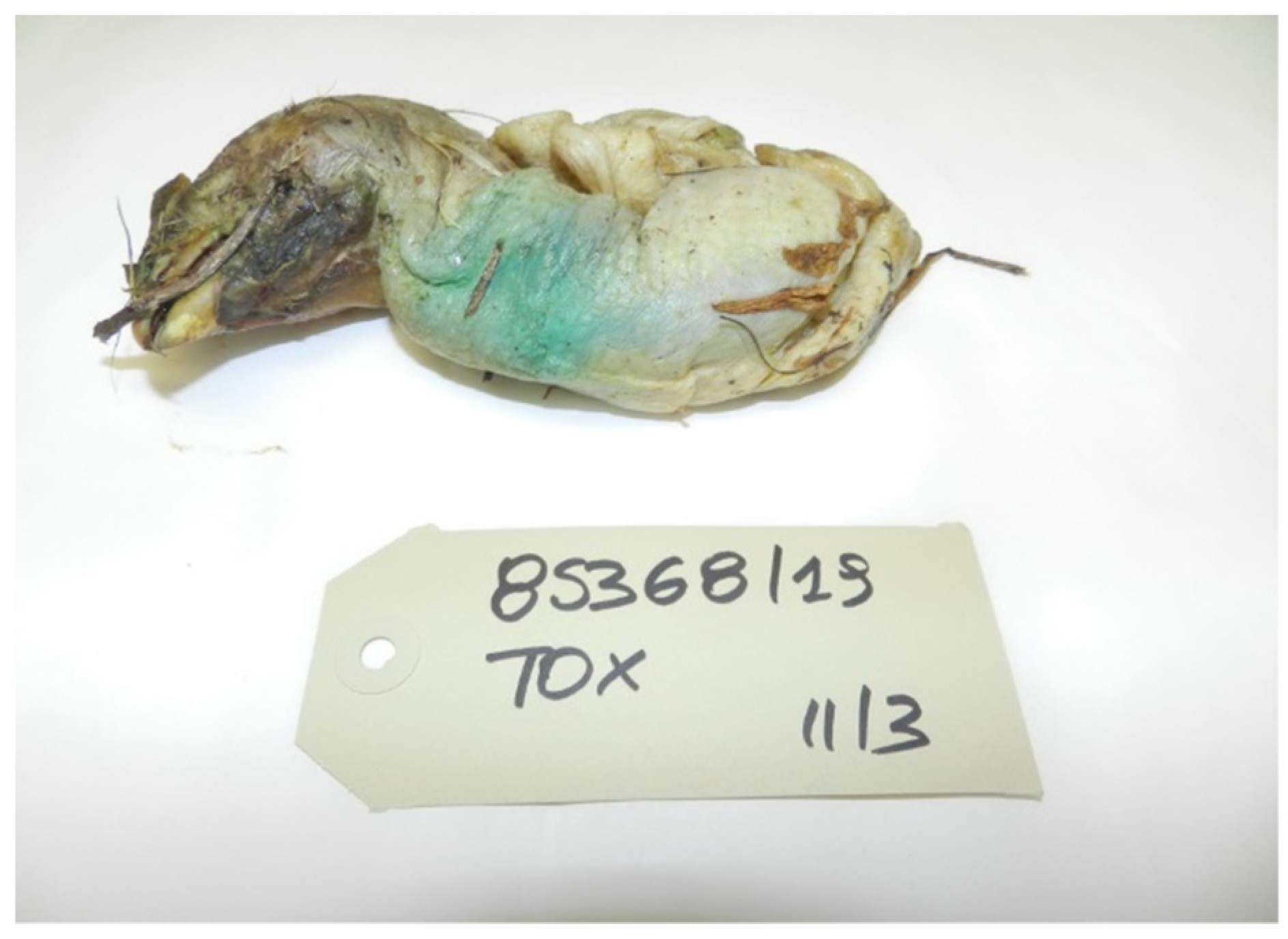
Publisher’s Note: MDPI stays neutral with regard to jurisdictional claims in published maps and institutional affiliations. |
© 2022 by the authors. Licensee MDPI, Basel, Switzerland. This article is an open access article distributed under the terms and conditions of the Creative Commons Attribution (CC BY) license (https://creativecommons.org/licenses/by/4.0/).
Share and Cite
Biancardi, A.; Aimo, C.; Piazza, P.; Lo Chiano, F.; Rubini, S.; Baldini, E.; Vertuani, S.; Manfredini, S. Acetylcholinesterase (AChE) Reversible Inhibitors: The Role of Oxamyl in the Production of Poisoned Baits. Toxics 2022, 10, 432. https://doi.org/10.3390/toxics10080432
Biancardi A, Aimo C, Piazza P, Lo Chiano F, Rubini S, Baldini E, Vertuani S, Manfredini S. Acetylcholinesterase (AChE) Reversible Inhibitors: The Role of Oxamyl in the Production of Poisoned Baits. Toxics. 2022; 10(8):432. https://doi.org/10.3390/toxics10080432
Chicago/Turabian StyleBiancardi, Alberto, Cristina Aimo, Pierluigi Piazza, Federica Lo Chiano, Silva Rubini, Erika Baldini, Silvia Vertuani, and Stefano Manfredini. 2022. "Acetylcholinesterase (AChE) Reversible Inhibitors: The Role of Oxamyl in the Production of Poisoned Baits" Toxics 10, no. 8: 432. https://doi.org/10.3390/toxics10080432
APA StyleBiancardi, A., Aimo, C., Piazza, P., Lo Chiano, F., Rubini, S., Baldini, E., Vertuani, S., & Manfredini, S. (2022). Acetylcholinesterase (AChE) Reversible Inhibitors: The Role of Oxamyl in the Production of Poisoned Baits. Toxics, 10(8), 432. https://doi.org/10.3390/toxics10080432







